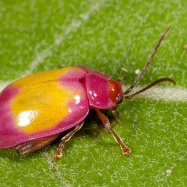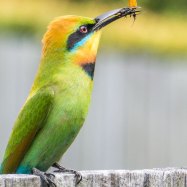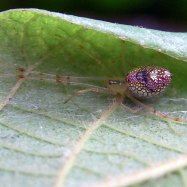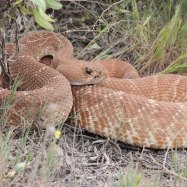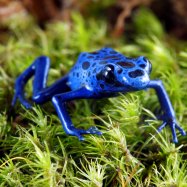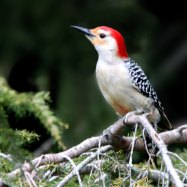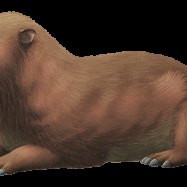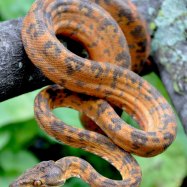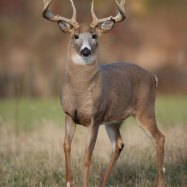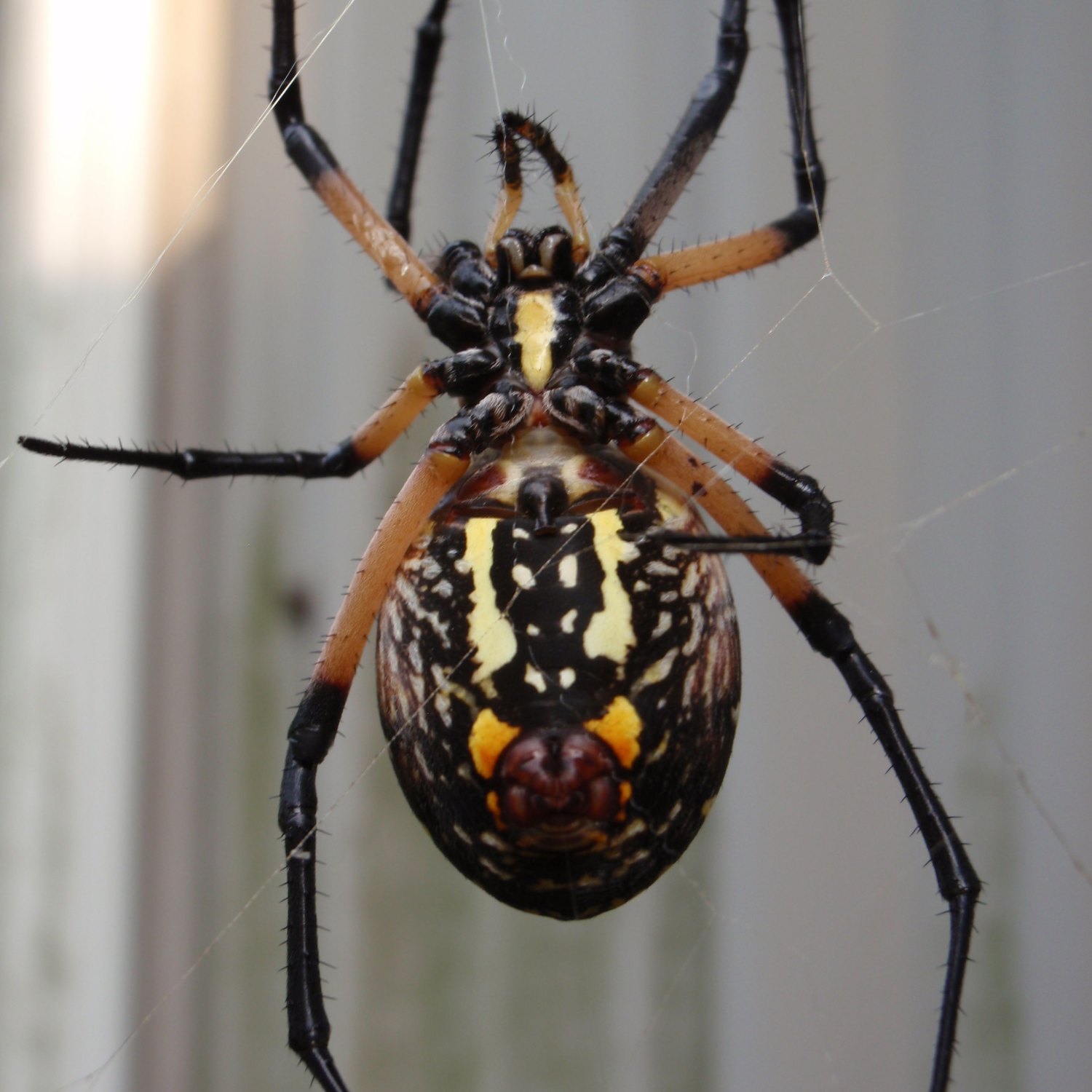
Barn Spider
Females: 10-18 mm, Males: 5-9 mm
Did you know that the Barn Spider, also known as the orb-weaver, is found throughout North America? These medium-sized spiders have a round abdomen and long legs, and can grow to be 10-18 mm for females and 5-9 mm for males. Keep an eye out for these skilled weavers in your barn or backyard! #BarnSpider #NorthAmericanAnimals #OrbWeaver
Animal Details Summary:
Common Name: Barn Spider
Kingdom: Animalia
Habitat: Barns, sheds, tall grass, gardens
Barn Spider: A Fascinating Predator Lurking in Plain Sight
As the warm sun sets on a picturesque barn, the farmer finishes his evening chores and heads inside for dinner. Soon, the peaceful stillness of the evening will be replaced by the busy activity of its inhabitants. But one creature, often overlooked and misunderstood, will emerge to take center stage – the Barn Spider.Scientifically known as Araneus cavaticus, this spider is also commonly referred to as the Barn Spider Barn Spider. Belonging to the kingdom Animalia, phylum Arthropoda, class Arachnida, and order Araneae, the Barn Spider is a fascinating creature that can be found lurking in barns, sheds, tall grass, and gardens throughout North America.
Habitat and Distribution
As the name suggests, the Barn Spider can often be found in barns and other man-made structures, making their homes in the nooks and crannies of these buildings. They are also commonly found in sheds, which offer similar hiding spots and an abundance of prey. However, these resourceful spiders can adapt to almost any environment and can also be found in tall grass and gardens.The Barn Spider is native to North America, with its range spanning across the entire region. This means that they can be found in Canada, the United States, and Mexico. In fact, they are so widespread that they can be found in almost every state in the US. This wide distribution is due to their adaptability and ability to thrive in a variety of environments.
Appearance and Behavior
At first glance, the Barn Spider may seem like any other spider, but upon closer inspection, their unique characteristics become apparent Bearded Fireworm. They have a medium-sized body, with a round abdomen and long legs. The males of this species are significantly smaller than the females, with lengths ranging from 5-9 mm, while females typically range from 10-18 mm.One of the most striking features of the Barn Spider is its coloration. While their coloration can vary, they are often brown or gray with yellow or orange markings. These markings serve as a form of camouflage, allowing them to blend into their surroundings and remain hidden from potential predators.
These spiders are solitary creatures and are rarely seen venturing out of their webs. They are primarily active at night, patiently waiting for unsuspecting prey to become tangled in their intricate webs. They are also known for their ability to produce silk, which they use to create elaborate webs and cocoons for their eggs.
Diet and Feeding Method
Like all spiders, the Barn Spider is a carnivorous creature and relies on a diet of insects for survival. Most commonly, they feed on flying insects such as flies, mosquitoes, and moths, which they catch in their webs. However, they are also known to hunt and feed on smaller spiders, as well as other barn-dwelling insects.Their feeding methods are also worth noting. Unlike other spiders that use venom to immobilize their prey, the Barn Spider relies on speed and agility. When an insect becomes trapped in their web, the Barn Spider will quickly pounce on it, wrapping it in silk and injecting it with digestive enzymes. These enzymes break down the insect's body, allowing the spider to suck out the nutrients.
Importance to the Ecosystem
While many may view spiders as unwelcome pests, they actually play an essential role in the ecosystem. As predators, they help keep the population of insects in check, preventing them from overpopulating and causing damage to crops and other plants. In fact, without spiders, the world would be overrun with insects, which would have severe consequences on the delicate balance of the ecosystem.Additionally, spiders are a vital source of food for other animals, such as birds and small mammals. And their webs, although often seen as a nuisance, are actually a crucial part of the food chain, providing shelter and food for many small insects and even some birds.
Fascinating Facts
- The silk of the Barn Spider is incredibly strong and is often used in the production of parachutes and bulletproof vests.- Unlike many other spiders, the Barn Spider does not spin a new web every day. Instead, they simply repair and maintain their existing web.
- Females of this species are known to kill and eat their male counterparts after mating. However, this is not always the case, and some males are lucky enough to escape unharmed after mating.
- The silk produced by the Barn Spider is not only strong but also elastic. This allows their webs to expand and contract as prey becomes trapped, preventing damage to the web.
- These spiders are considered to be a sign of good luck in some cultures and are often seen as a symbol of hard work and perseverance.
In Conclusion
In conclusion, the Barn Spider may seem like an unassuming creature, but it is a vital part of the ecosystem. Their ability to adapt to different environments, their unique appearance and behavior, and their important role as predators make them a fascinating subject. So, the next time you see a web in your barn or shed, take a moment to appreciate the hard work and skills of the Barn Spider.

Barn Spider
Animal Details Barn Spider - Scientific Name: Araneus cavaticus
- Category: Animals B
- Scientific Name: Araneus cavaticus
- Common Name: Barn Spider
- Kingdom: Animalia
- Phylum: Arthropoda
- Class: Arachnida
- Order: Araneae
- Family: Araneidae
- Habitat: Barns, sheds, tall grass, gardens
- Feeding Method: Carnivorous
- Geographical Distribution: North America
- Country of Origin: United States
- Location: Throughout North America
- Animal Coloration: Varies, often brown or gray with yellow or orange markings
- Body Shape: Medium-sized, round abdomen, long legs
- Length: Females: 10-18 mm, Males: 5-9 mm
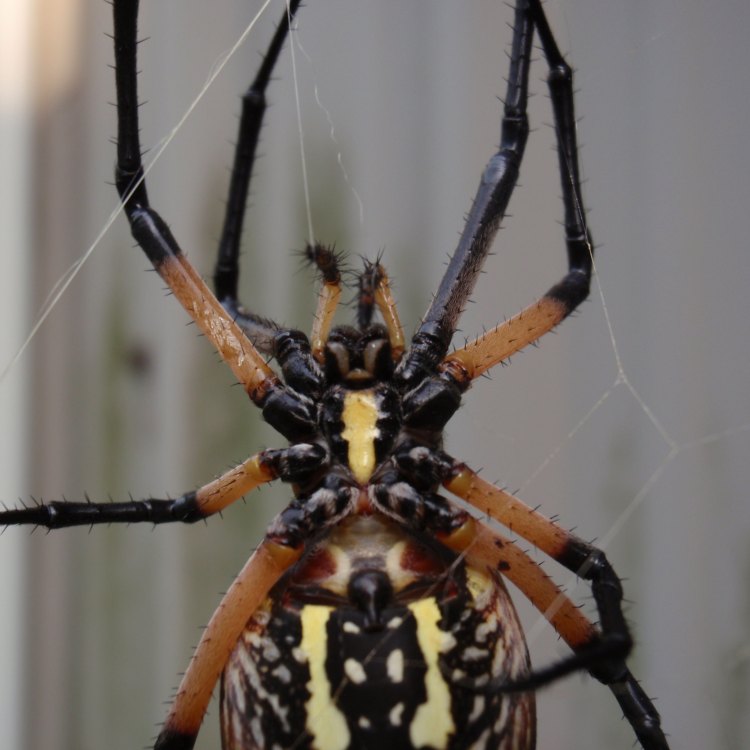
Barn Spider
- Adult Size: Females: 10-18 mm, Males: 5-9 mm
- Average Lifespan: 1-2 years
- Reproduction: Sexual
- Reproductive Behavior: Males produce sperm webs and transfer sperm to females during mating
- Sound or Call: No sound production
- Migration Pattern: Non-migratory
- Social Groups: Solitary
- Behavior: Spins intricate orb webs to catch prey
- Threats: Predators, habitat loss
- Conservation Status: Not evaluated
- Impact on Ecosystem: Help control insect populations
- Human Use: None
- Distinctive Features: Orb webs, round abdomen
- Interesting Facts: Barn spiders are common in rural areas and are often found in barns and sheds
- Predator: Birds, small mammals
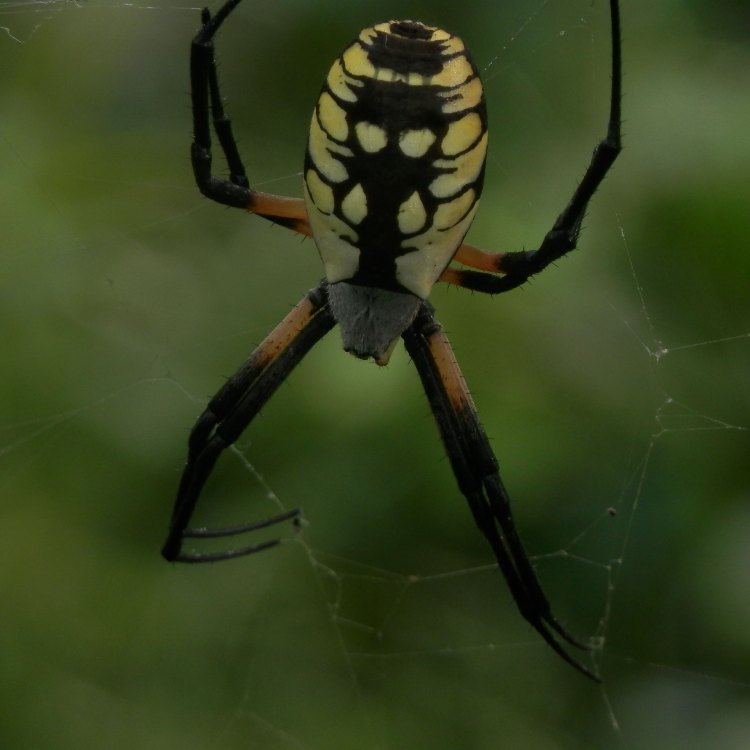
Araneus cavaticus
The Fascinating World of the Barn Spider
When it comes to spiders, most people have a strong reaction – either fear or fascination. These eight-legged creatures have been the subject of many myths and legends throughout history. From the famous Charlotte in E.B PeaceOfAnimals.Com. White's "Charlotte's Web" to the creepy giant spiders in J.R.R. Tolkien's "The Lord of the Rings," these creatures have captured our imaginations.One spider that often goes unnoticed is the barn spider. But despite its common name, this spider is anything but ordinary. In fact, it has many unique features and behaviors that make it stand out in the world of spiders. In this article, we will explore the interesting world of the barn spider, from its physical characteristics to its impact on the ecosystem.
The Basics of a Barn Spider
The scientific name for barn spider is Araneus cavaticus, which comes from the Greek words for "spider" and "hollow place Belgian Tervuren." This name is appropriate as these spiders are commonly found in hollow places such as barns, sheds, and other man-made structures. They can also be found in gardens, fields, and woods, making their home in any secluded spot with ample food supply.
The adult size of a barn spider varies between males and females. Females are usually larger, measuring 10-18mm in length, while males are 5-9 mm. They have eight long legs and their bodies are divided into two main parts – the cephalothorax (head and thorax combined) and the abdomen. The color of their bodies can range from light brown to dark brown, sometimes with a yellow or orange pattern on their abdomen.
In terms of lifespan, barn spiders live for about 1-2 years. They reach sexual maturity in their first year and usually die after mating. However, females can potentially live longer if they mate more than once in their lifetime.
Reproductive Behavior and Social Groups
As with most spiders, the barn spider reproduces sexually. This means that the males must find a way to transfer their sperm to the female's reproductive organs for fertilization to occur. To do this, male barn spiders produce sperm webs. These are small, intricate webs that they fill with sperm before approaching the females. When a male finds a suitable female, he will use his legs to place the sperm on her genital opening.
Barn spiders are solitary creatures and do not form social groups. In fact, they are known to be rather aggressive towards other spiders, especially when it comes to defending their territories and food sources. This solitary nature also applies to their choice of habitat. They prefer to live alone and only come together for mating.
The Intricate Orb Webs and Hunting Behavior
One of the most distinctive features of barn spiders is their ability to spin intricate orb webs. These webs are circular in shape and are often seen suspended between buildings, tree branches, or even blades of grass. They are made out of silk, which the spider produces from its spinneret glands.
The orb webs are used for hunting as they are highly effective in catching prey. The sticky nature of the silk ensnares unsuspecting insects that land on the web, trapping them for the spider to consume. This hunting behavior is essential for the survival of barn spiders, as they rely on a steady diet of insects.
Threats and Conservation Status
Like all creatures, barn spiders are not immune to threats. Their main predators are birds and small mammals like shrews and mice. These predators view barn spiders as a tasty treat and can significantly decrease their population in a particular area. In addition to predators, habitat loss is also a threat to the survival of these spiders. As humans continue to develop and expand, natural habitats for barn spiders are destroyed, leaving them with fewer places to call home.
Despite these threats, the conservation status of barn spiders has not been evaluated. This is mainly because they are widespread and abundant in many areas, making their survival currently not a concern. However, as with all living creatures, it is essential to be mindful of our actions and their impact on the environment to ensure the continued existence of all species.
Impact on the Ecosystem
Barn spiders may be small in size, but they play a crucial role in the ecosystem. As predators, they help control the population of insects, such as flies, mosquitoes, and moths, which can be considered pests. Without barn spiders, these insect populations could grow out of control, causing imbalances in the ecosystem and potentially disrupting the food chain.
In addition, barn spiders also contribute to nutrient cycling. As they consume insects and other small creatures, they release nutrients back into the soil, aiding in the growth of vegetation.
Interesting Facts About Barn Spiders
There are many intriguing facts about barn spiders that make them stand out from other spiders. Here are some interesting things you may not know about them:
- As their name suggests, barn spiders are commonly found in rural areas, particularly in farm buildings such as barns, sheds, and stables.
- Despite their widespread existence, barn spiders are not considered a garden pest. They do not pose any harm to humans or plants and prefer to stay out of sight.
- Barn spiders do not produce any sound or call. They are generally quiet creatures and rely on their webs to catch prey.
- These spiders are non-migratory. They do not travel long distances and tend to stay in the same area throughout their lifetime.
- Barn spiders do not have any significant human use. They are not used for medical purposes or as a food source, unlike some other spider species.
- One of the most noticeable features of barn spiders is their round abdomen. Unlike other spiders with elongated abdomens, theirs are more spherical in shape.
In Conclusion
Despite their common presence, barn spiders have many unique features and behaviors that make them a fascinating species. From their intricate orb webs to their solitary lifestyle, these spiders have adapted to survive in various environments. As humans, it is essential to appreciate the role they play in balancing the ecosystem and be mindful of our actions to ensure their continued existence. So the next time you come across a barn spider, take a moment to observe and appreciate these underrated creatures.
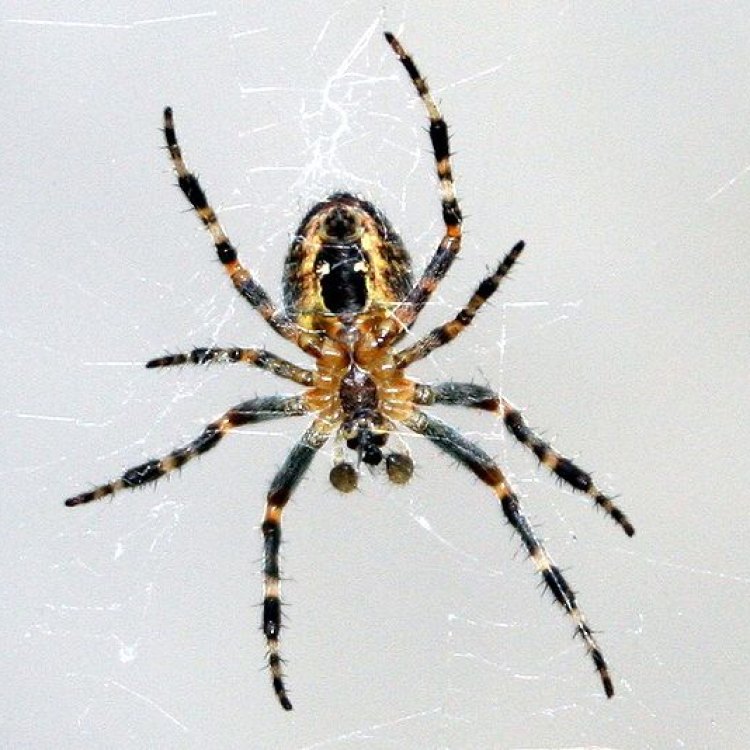
Barn Spider: A Fascinating Predator Lurking in Plain Sight
Disclaimer: The content provided is for informational purposes only. We cannot guarantee the accuracy of the information on this page 100%. All information provided here may change without prior notice.

